
- Community Marketing
- Customer Acquisition
- Customer Marketing
Community Engagement Marketing: Building Lasting Customer Relationships
Lindsay Kolinsky | Mar 17, 2025
May 22, 2024 | 12 minute read
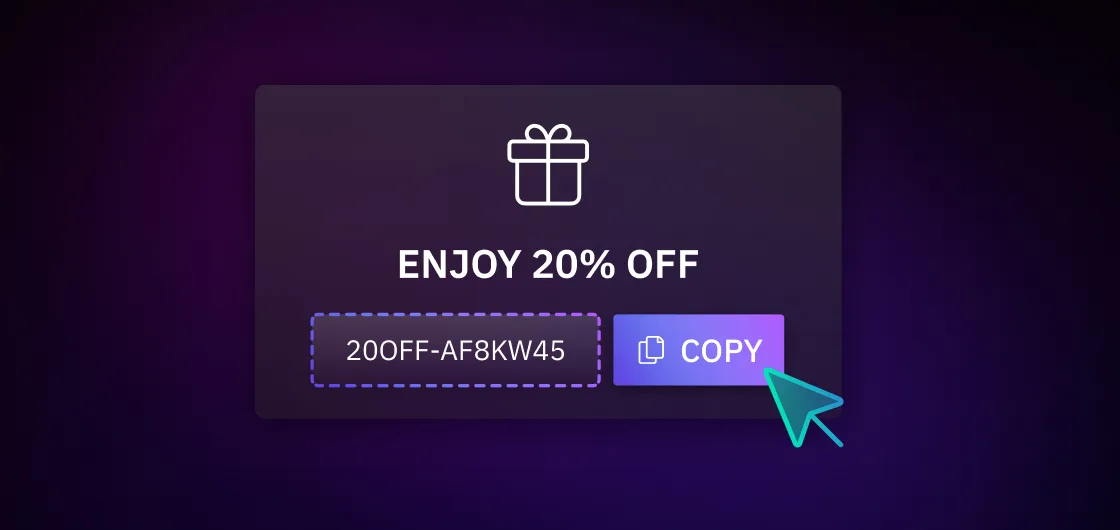
Megan Wenzl
Content Marketing Manager
This article discusses the significance of referral codes in modern marketing, emphasizing their role in your customer acquisition, loyalty building, and brand advocacy. It explains the differences between referral codes and links, outlines steps for setting up a program, and offers real-world examples. Additionally, it highlights benefits, implementation considerations, best practices, and the utility of Okendo Referrals.
With costs per acquisition rising, paid media becoming more competitive, and the DTC landscape getting more saturated by the day, it is increasingly important for brands to keep existing customers, build trust, and foster customer loyalty and commitment.
Referral codes are an increasingly effective tool for leveraging an existing customer base to create an entirely free marketing channel, capitalizing on the high-quality experience that has already been delivered to existing customers.
This guide clarifies what a referral code is and how to best use it for subtle yet successful advertising that will preserve brand image while also driving high-converting traffic to your website.
Put simply, a referral code is an individual discount code provided to customers to incentivize referrals. In a sense, referral codes represent brands’ attempts to digitize word-of-mouth advertising so that it can be tracked, measured, and incorporated into the greater digital strategy.
Referral codes are used in ecommerce for multiple purposes. While they are primarily used to mobilize or incentivize brand advocates to refer additional customers to the website, they are also used to inspire customer loyalty, foster partnerships with influencers or affiliates, and better understand the halo effect of other marketing channels. When you can track the effectiveness of your campaigns and the halo effect they may have on referral traffic, you are much better able to strategize and allocate media budget to the most effective strategies thus improving your customer acquisition cost (CAC).
Referral codes and referral links differ in their shareability, distribution, and potential for virality. A referral code is a traceable discount code (sometimes in the form of a vanity code) that ties a transaction to the customer or brand advocate. An advantage of referral codes is that they can incentivize true word-of-mouth advertising especially if they are not single-use codes.
A referral link is more stringent in that the recipient must make a purchase through a specific, individualized link in order to receive a reward. Referral links allow for customers to easily share their unique link to their social media following or share the link with friends or family members.
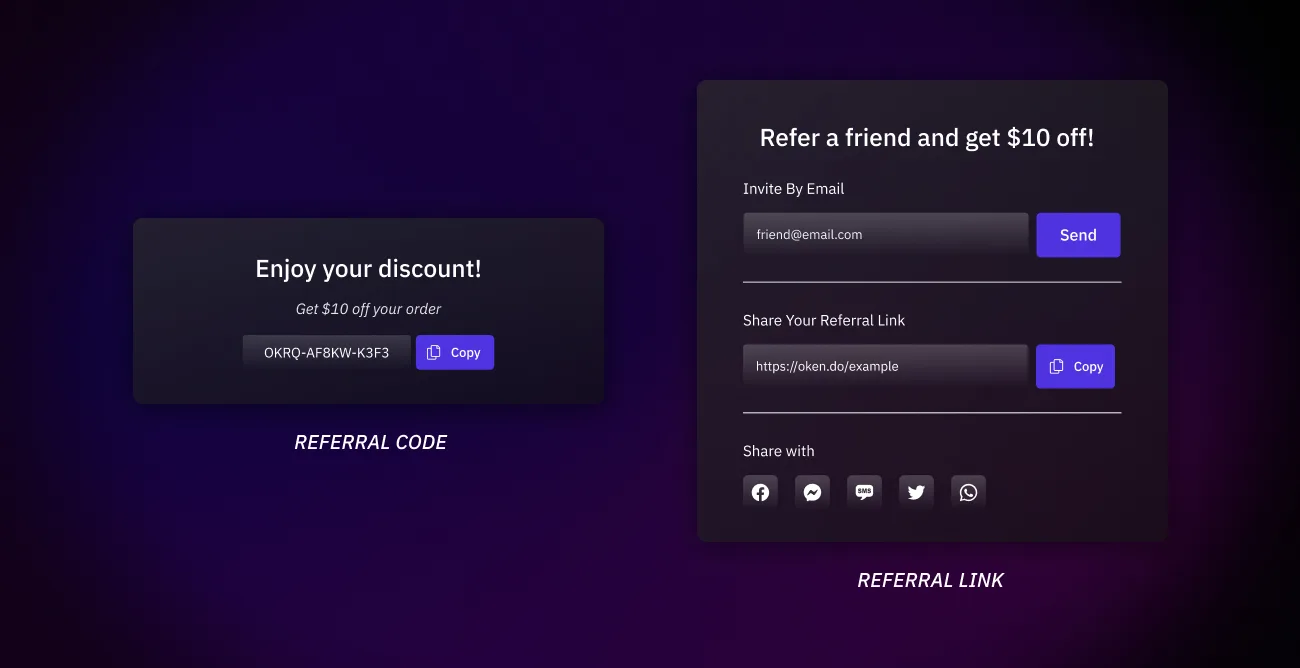
Referral programs can take many formats that set up referral codes to work in different ways. A referral vanity code, for example, is a form of co-branding and provides the advocate (usually an influencer, another brand, or organization) a branded discount code that they can distribute to incentivize their audience to visit your brand’s website. The recipients can then use the code for a discount and the code’s usage can be tracked to reward or give commission to the referrer.
Customer-to-customer referral codes can offer the same discount or offer to both the referrer and the recipient. For example, “give 10% off, get 10% off.” In this scenario, the referrer would send an individual, one-time-use 10% off code to a friend or family member. If the recipient makes a purchase and uses the code, then the original referrer would also receive the same 10% discount with their own individual one-time use code.
The first step to setting up a referral program is to define the terms, conditions, formatting, incentives, and rewards. It is important in this first step to consider your brand’s goals in creating a referral program as different goals would warrant different parameters of the program. Okendo Referrals makes it easy to create a high-performance referral program for your Shopify store.
Richard Emanuel, Co-founder of Parkfield Commerce, says “Referral programs are essential for ecommerce brands because they leverage the trust and credibility of personal recommendations, leading to cost-effective customer acquisition and higher conversion rates. These programs also enhance customer engagement and expand brand reach by incentivizing existing customers to share their positive experiences within their networks.”
The next step in setting up a referral program is to create a system that generates and assigns unique referral codes to customers. Okendo’s referral program creates automations so customers receive individual codes with your brand’s parameters in place, including:
It allows for customization to align with your brand’s objectives as well as traceability and analytics to evaluate the effectiveness of the program.
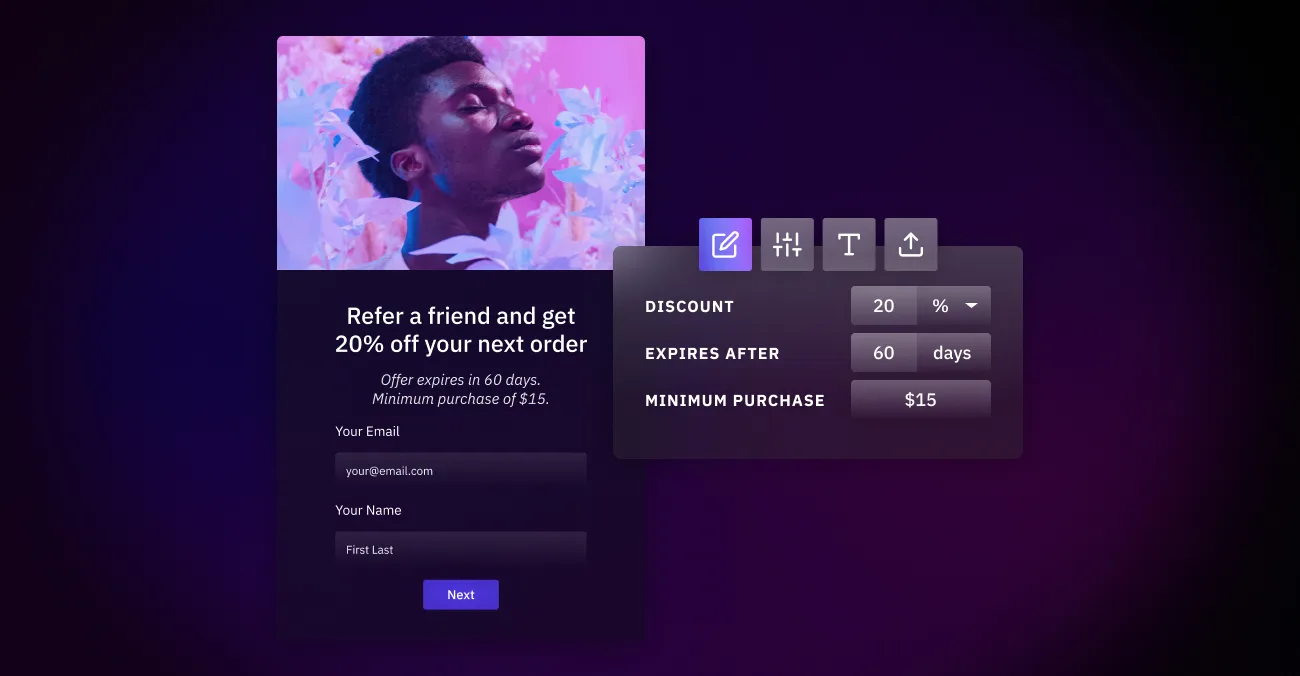
Once your unique referral codes and automations are set up, you will need to track their redemption and distribute rewards to the referrer. Oftentimes referral programs offer the same reward to both the referrer and the recipient, but you can create a variation in which the referrer receives cumulative rewards based on how many referrals they make.
Depending on your program’s format, be sure to track the usage of the referrer’s code or codes and create an automated system that grants the reward or rewards to the customer. It is important that your Superfans, or brand advocates, receive their rewards promptly and seamlessly to ensure a customer experience that inspires brand loyalty.
Since these customers actively promote your brand, they need to be treated with a high level of consideration and thoughtfulness to maintain a high level of trust and loyalty. Okendo Referrals automatically tracks redemption and distributes rewards based on the customizable format for your brand so that the experience is prompt, frictionless, effective, and positive for both the referrer, recipient, and brand.
Referral codes are simple yet effective means of administering a referral program and capitalizing on a digital form of word-of-mouth advertising. They are flexible, customizable, and when used correctly, can serve as an effective ecommerce growth strategy to help your brand achieve its revenue goals without compromising brand image.
Referral codes are a subtle and sophisticated way to increase traffic, build a loyal following, foster relationships with brand advocates, and create a halo effect that optimizes other digital marketing channels. Below are a few benefits of referral codes and reasons to incorporate them into your referral program or greater marketing strategy.
Experienced marketers know acquiring new customers is far more involved, costly, and difficult than keeping existing customers. The use of referral codes allows brands to mobilize their existing customers, encourage them to be brand advocates, and potentially acquire new customers through a digital form of word-of-mouth advertising and endorsement.
Customer loyalty is increasingly important with rising acquisition costs. Referral codes are an indication to your customers that you care about their experience and reward loyalty and brand advocacy. When a loyal customer is rewarded for their referrals, they are much more likely to have a positive impression of the brand and return for repeat purchases.
Further, the customers whom they refer are much more likely to have a positive first impression of your brand and might even be influenced to become brand advocates themselves.
Referral traffic is almost as cost-effective as word-of-mouth advertising since the bulk of the cost comes from acquiring the original or referring customer. Setting up a referral program is easy, straightforward, and requires very little manual effort. It is one of the few channels that does not require an initial investment and has few repeat costs beyond the discount provided to customers (which are dependent on the program’s success and scalability).
Creating a referral code with Okendo involves using the referral platform to input the parameters of your discount offer, customizing the display of the referral prompts, creating referral email templates, and any additional messaging such as landing pages or pop-ups to advertise the program.
The interface in the referral platform allows for easy adjustment of the codes including discount percentage or value, the type of coupon, minimum purchase amount, expiry, and products the coupon code applies to.
Referral codes are used by countless ecommerce brands to leverage their fanbase and create a free, high-converting marketing channel using their existing customer base. Here are 4 real-world examples of effective referral codes created using the Okendo Referrals platform.
The Collagen Co. created a referral program through Okendo which identifies their most loyal, engaged customers and seamlessly sends referral requests. The program offers both the recipient and the referrer a $25 reward on their next purchases.
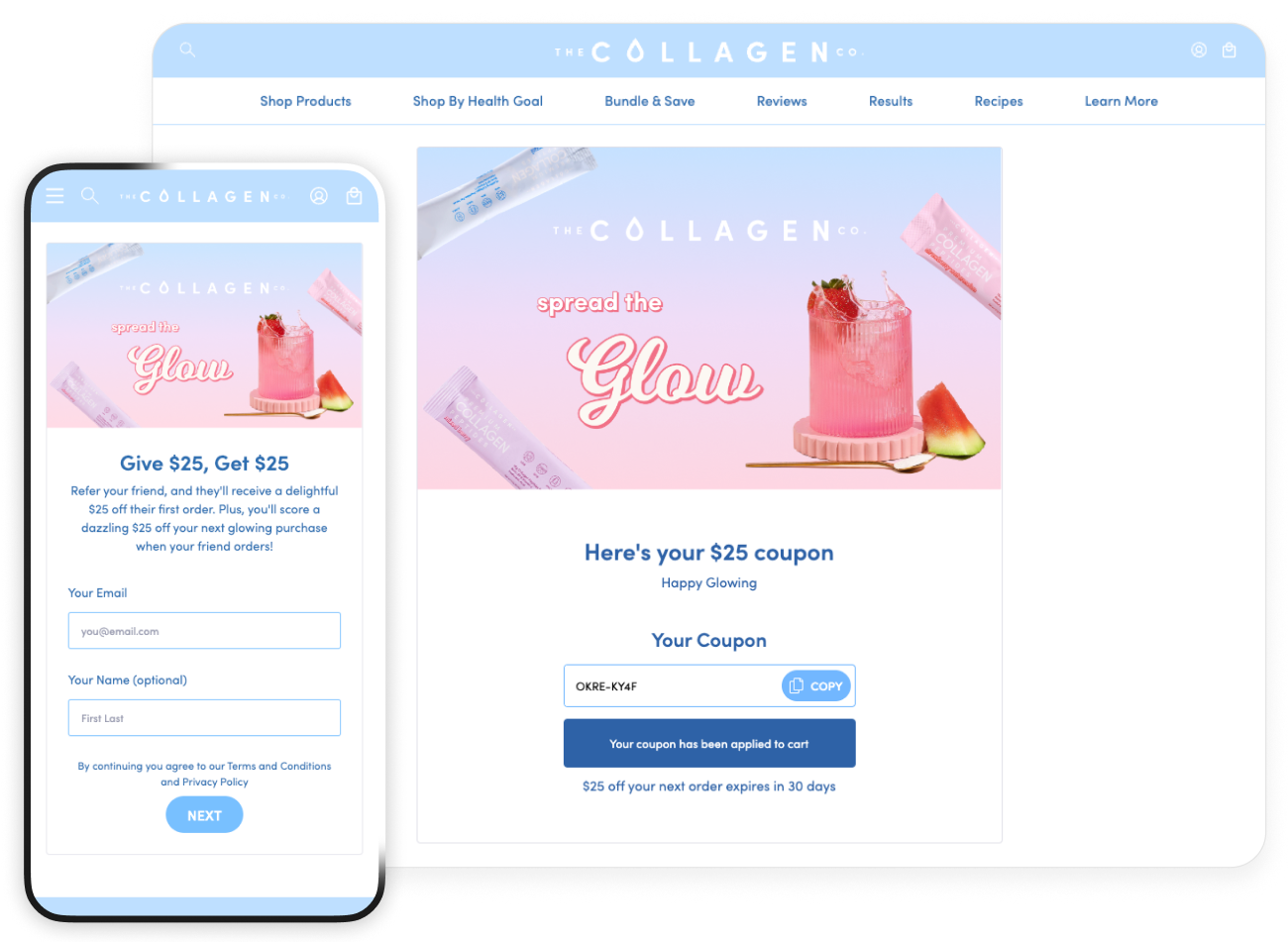
Pillow Cube uses the Okendo referrals service to advertise a 10% discount on their site if customers “refer a friend in 3 simple steps” thereby messaging the ease and simplicity of referring friends and family members in order to receive an instant reward.
Pillow Cube also uses Quizzes, Reviews, and Referrals to double down on its loyalty-building efforts, streamline processes, and create Superfans of the brand for sustainable revenue growth. Marketing Director, Lane Olson says, “Our revenue grew year-over-year, and using Okendo was part of that growth.”
Grace & Lace utilizes Okendo to send automatic referral requests to customers who reviewed a product with a 4 or 5-star rating, thereby creating Superfans and increasing the effectiveness of their reviews program. Their program offers a $10 discount to both the referrer and recipient.
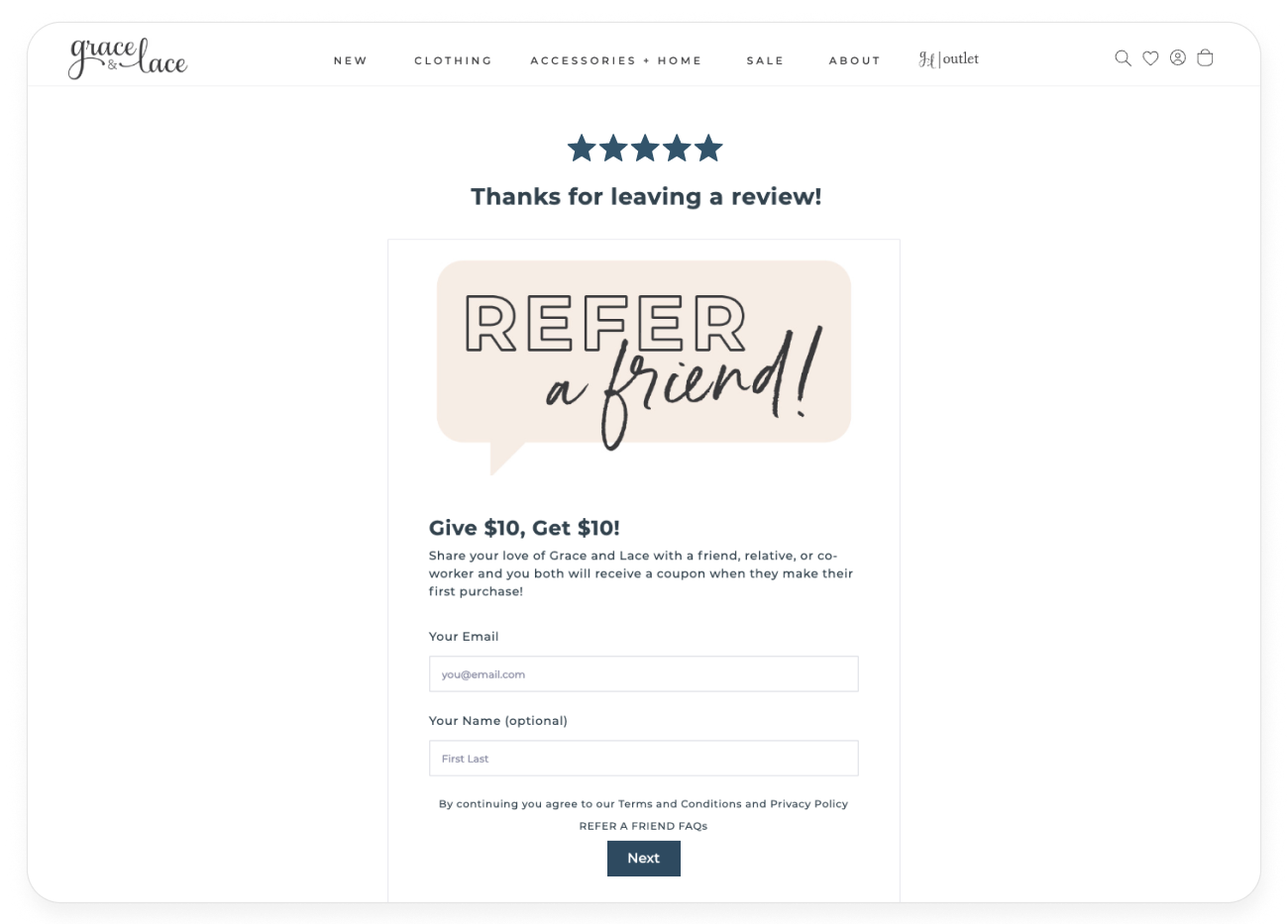
Reid Cycles offers a referral program in which referrers and recipients both receive a $20 credit on their next purchase. The brand was further able to streamline processes by using both Okendo’s Reviews and Referral products.
Any brand looking to grow sustainably should consider creating a referral program as an easy, cost-effective, and simple way to increase loyalty and optimize existing customers. Before you begin implementing a referral program, there are several things to consider and ask yourself to determine if the timing is right.
It’s important to establish a strong foundation for your referral program. Here’s what you need to do:
Ensure that your referral codes are understandable with clear and digestible discount offers or rewards. Simple messaging like “Give $20, Get $20” or “Send 10% Off, Receive 10% Off” is easy to understand and takes the guesswork of how to earn the incentive.
To make the referral experience feel special and encourage customer loyalty, ensure your templates for advertising the program include personalized messaging that is tailored to the specific customer and their relationship with the brand. Better yet, consider tiering the rewards so that the most loyal customers or “Superfans” receive a greater incentive than the baseline.
Referring customers are donating time and energy into referring your brand. To make it as easy as possible for them, ensure the experience is simple and accessible. Make the program readily available at major touchpoints throughout the customer experience and perform regular audits on the functionality from end to end.
Replicate the same effects as word-of-mouth advertising by promoting the sharing of the referral program. Incorporate advertising of the referral program into your on-site experience and reiterate the program for your customers’ consideration throughout the customer lifecycle. After a successful referral, try creating additional referrals by outlining the referral program to the new customer post-purchase.
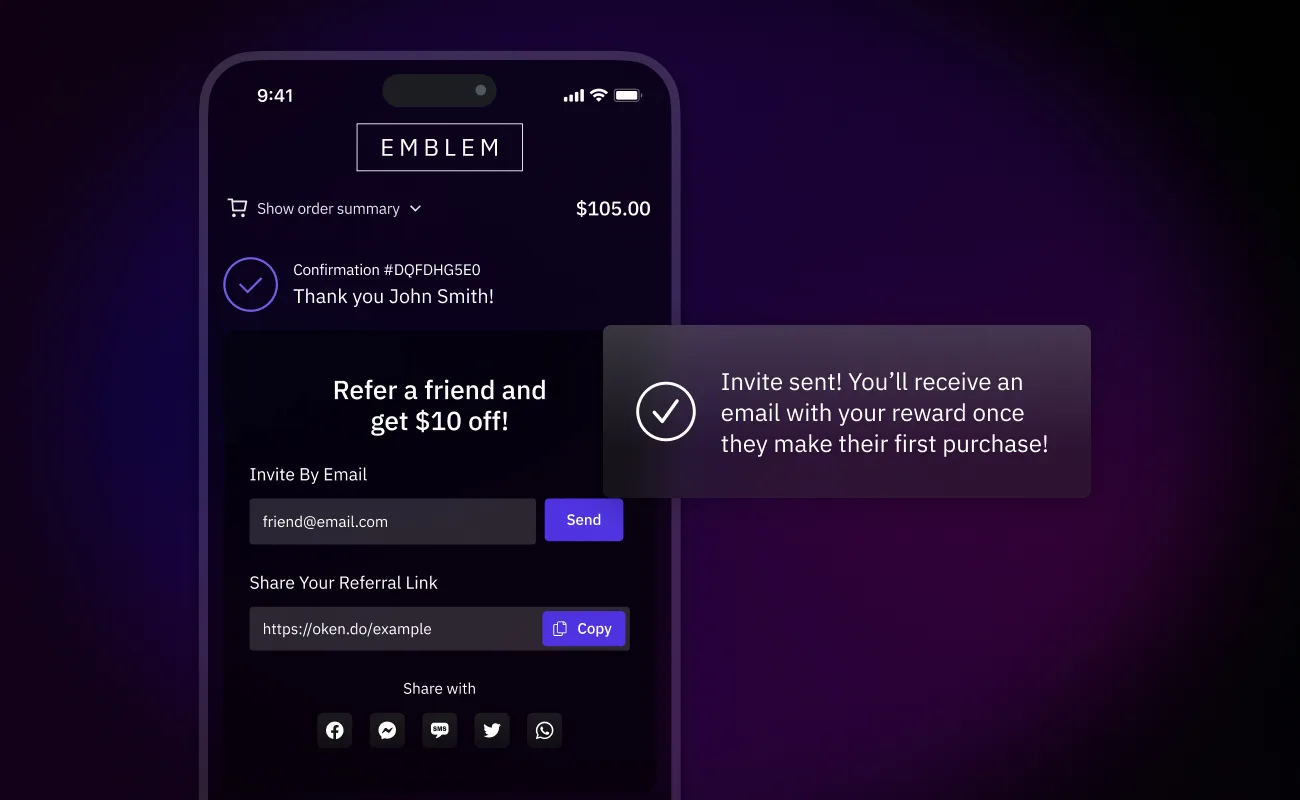
Okendo Referrals can help your brand streamline referral processes, reduce workload, create personalized experiences, and generate cost-effective revenue for a sustainable positive impact on your bottom line.
The platform gives flexible sender and recipient rewards, automation for instant gratification and a pleasant referral experience, fully customizable templates, and consistent consultation to help your brand achieve continued success with your referral program. Okendo’s program is especially helpful in automatically generating and managing referral codes so that you can analyze results and spend practically no time figuring out the logistics.
Referral marketing is a low-cost, measurable, simple, and effective way to acquire new customers, optimize existing customers, build brand loyalty, and preserve reputation while offering customers incentives. If your brand is looking for sustainable growth by mobilizing Superfans, or highly engaged brand advocates, consider Okendo Referrals to streamline and automate the processes and create personalized customer experiences.
A referral code can look like an individual, one-time use code with a combination of numbers and letters or it can look like an easy-to-share personalized link
Brands with a referral program will outline the conditions and requirements for receiving a referral code. Often a referral code just needs to be circulated and used by at least one other friend in order to redeem the reward.
Usually, a referral code is provided by the brand when a customer completes a qualifying action. Discount codes can be created from a number of programs, but the automation and integration with other Shopify apps are what drives the cost of creating referral codes.
Yes! Referral programs are cost-effective and represent a significant ROI which is not even taking into account the brand loyalty and returning customer rate as a result of the program.
Related articles
Ready to learn more?